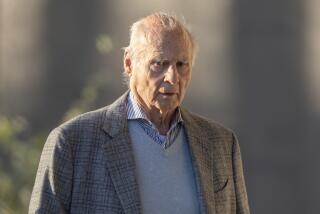Book review: ‘The Wizard of Lies: Bernie Madoff and the Death of Trust’
- Share via
Three days. That’s how close Bernard Madoff’s $65-billion Ponzi scheme came to collapsing back in November 2005.
The high-profile Bayou hedge fund had failed, and droves of newly anxious investors were pulling money out of investment businesses such as Madoff’s. He owed $105 million in redemption checks to investors, but the fraudulent investment business’ JPMorgan bank account had just $13 million.
As Diana Henriques documents in her new book, “The Wizard of Lies: Bernie Madoff and the Death of Trust,” Madoff was able to cover the difference only by pulling money from his legitimate brokerage business and by appropriating client assets to get a $95-million loan.
Then a timely investment from a client allowed Madoff to stay afloat and suck in billions more dollars from hedge funds around the world, creating what may well be the biggest investment scam of all time.
Yet the cash flow problem was not his only close call. Published by Times Books, “The Wizard of Lies” reveals many moments when Madoff might have been stopped. But his investors were too trusting or too greedy to ask the right questions, and U.S. regulators were too cowed and too disorganized.
In one telling moment just a few months after Madoff’s 2005 cash crisis, the U.S. Securities and Exchange Commission — tipped off by a skeptical analyst — asked the former Nasdaq chairman for a list of accounts he used to trade securities and options for the investment business.
But Madoff had done no trading for the investment business in decades. So, Henriques writes, “Madoff gambled big” — and simply made up a six-page list of financial entities.
The SEC drafted letters to two on the list but never sent them. Despite a face-to-face meeting with Madoff in which the regulators caught him telling an obvious falsehood about his options trading, the commission concluded there was no evidence of fraud and allowed the investigation to peter out.
After interviewing several of the commission investigators, Henriques concludes: “The lie was simply too large to fit into the agency’s limited imagination.”
Her extensive research makes clear that Madoff’s blatant disregard for ethical limits started early. Just a couple of years after starting his brokerage business, he poured customer money into hot new stocks in violation of rules requiring that investments be “suitable.”
When the market turned in 1962 and the new issues dropped in value, he covered up, borrowing money from his father-in-law to buy back the investments secretly. It was a pattern that would repeat itself when the Ponzi scheme got going in earnest several decades later.
Cogent and well-researched, “The Wizard of Lies” is an engaging narrative that brings together much of the information that has emerged since Madoff confessed in December 2008.
Readers with only a cursory acquaintance with the Madoff scandal will find it an entertaining summary. But the book proves unsatisfying on several levels.
Despite several face-to-face interviews with her slippery protagonist, Henriques was unable to pin down a precise date for the start of the fraud — Madoff insisted he was legitimate until the early 1990s, while some authorities think the falsehoods started as early as the 1970s.
The author offers support for the idea that it was the years right after the 1987 stock market crash when some of his early big backers began pulling out their cash. But she has only circumstantial evidence for her conclusion.
The book is also testimony to the perils of writing a serious work about an event that is still unfolding. Over the last two years, so many details about the Madoff case have emerged that very little of the narrative feels new.
Henriques conducted extensive interviews with Madoff, but his answers often come across as glib or downright misleading — hardly surprising for a noted liar — and his character remains elusive. Although Henriques may have been first with the questions, Madoff was later interviewed by the New York Times and Financial Times, which published faster.
At the same time, continuing inquiries and litigation related to the case hamper Henriques’ efforts to answer the big remaining question: Was anyone else to blame?
She lays out a clear argument why Madoff’s closest relatives — his sons, wife and brother — may well have been his victims rather than co-conspirators, but she soft-pedals her conclusion because the probes are not yet done.
Similarly, continuing litigation filed by the bankruptcy trustee charged with recovering money for Madoff’s investors may well illuminate what, if anything, Madoff’s Wall Street and European counterparties knew. But those cases will take years to resolve.
Without concrete answers, Henriques is left to speculate on why Madoff was able to take in so many for so long. Her answer is prosaic: “Madoff was not inhumanly monstrous. He was monstrously human ... just like us — only more so.”
To her, Madoff is just one in a long line of schemers that will continue as long as investors continue to dream of risk-free returns. It is not a reassuring conclusion.
Masters is a correspondent for the Financial Times of London, in which this review first appeared.
More to Read
Inside the business of entertainment
The Wide Shot brings you news, analysis and insights on everything from streaming wars to production — and what it all means for the future.
You may occasionally receive promotional content from the Los Angeles Times.










